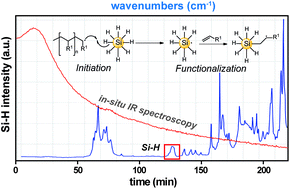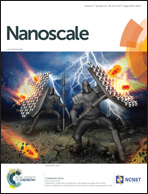In situ IR-spectroscopy as a tool for monitoring the radical hydrosilylation process on silicon nanocrystal surfaces†
Abstract
Among a variety of SiNC functionalization methods, radical initiated grafting is very promising due to its straightforward nature and low propensity to form surface oligomers. In the present study, we employed in situ IR spectroscopy in combination with visible light transmittance measurements to investigate the radical induced grafting process on the well-defined SiNCs. Our findings support the proposed model: unfunctionalized hydride-terminated SiNCs form agglomerates in organic solvents, which break up during the grafting process. However, clearing of the dispersion is not a valid indicator for complete surface functionalization. Furthermore, radical-initiated grafting reactions in which azobisisobutyronitrile (AIBN) is the initiator are strongly influenced by external factors including initiator concentration, grafting temperature, as well as substrate steric demand. The monomer concentration was proven to have a low impact on the grafting process. Based on these new insights an underlying mechanism could be discussed, offering an unprecedented view on the functionalization of SiNC surfaces via radical initiated hydrosilylation.



 Please wait while we load your content...
Please wait while we load your content...